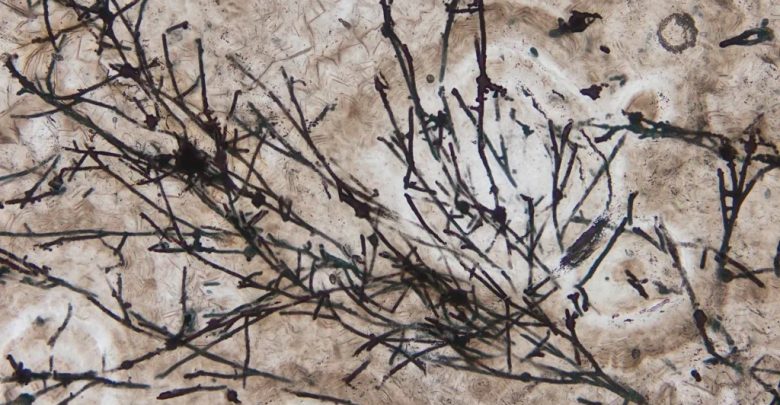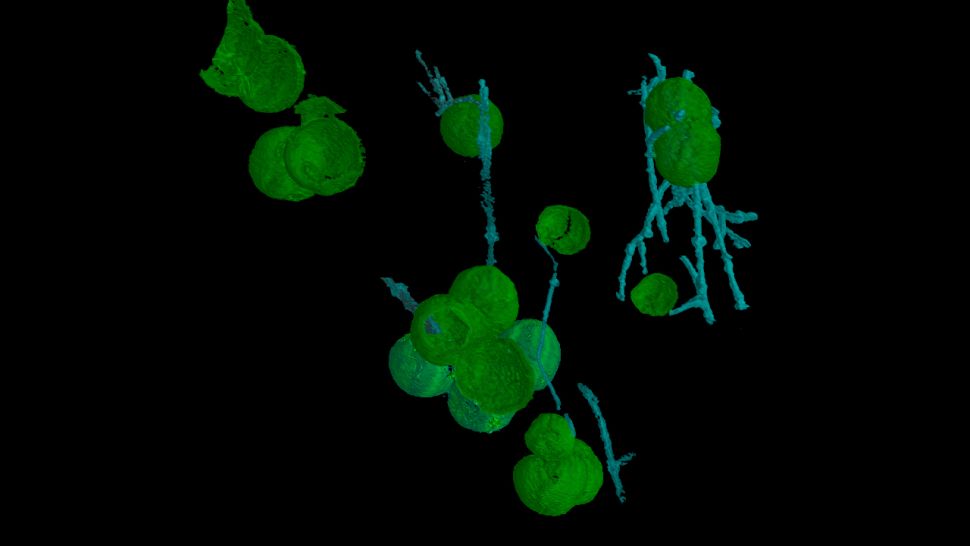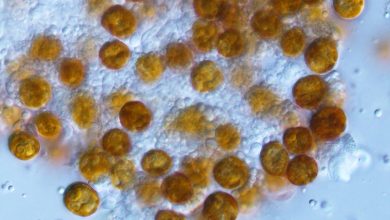
The oldest evidence of land fungus may be a tiny microfossil that’s 635 million years old, found in a cave in southern China.
Too small to be seen with the naked eye, this remarkable find pushes back the appearance of terrestrial fungus by about 240 million years to a period known as “snowball Earth” when the planet was locked in ice from 750 million to 580 million years ago.
When you think of fungi, what comes to mind may be a crucial ingredient in a recipe or their amazing ability to break down dead organic matter into vital nutrients. But new research by Shuhai Xiao, a professor of geosciences with the Virginia Tech College of Science, and Tian Gan, a visiting Ph.D. student in the Xiao lab, highlights yet another important role that fungi have played throughout the Earth’s history: helping the planet recover from an ice age.
“There’s an element of serendipity, but there’s also an element of experience and expectation. Having worked with microfossils, one knows what kind of rocks to look at,” Xiao told Live Science. For example, rocks must be fine-grained, because the fossils are so small. Color can also provide clues; organic carbon in microfossils can make fossil-bearing rocks look darker than rocks that don’t contain fossils.
“But it’s not error-proof; most times, we slice a rock, and we don’t find anything. There’s maybe a 10% success rate,” Xiao said.
The presence of land fungus at this critical point may have helped Earth to transition from a frozen ice ball to a planet with a variety of ecosystems that could host diverse life-forms, scientists wrote in a new study. By breaking down minerals and organic matter and recycling nutrients into the atmosphere and ocean, ancient fungus could have played an important part in reshaping Earth’s geochemistry, creating more hospitable conditions that paved the way for terrestrial plants and animals to eventually emerge and thrive.
A team of scientists from Virginia Tech, the Chinese Academy of Sciences, Guizhou Education University, and University of Cincinnati has discovered the remains of a fungi-like microfossil that emerged at the end of an ice age some 635 million years ago. It is the oldest terrestrial fossil ever found. To put it into perspective, this microfossil predates the oldest dinosaurs about three times over.
The fossil was found in small cavities within well-studied sedimentary dolostone rocks of the lowermost Doushantuo Formation in South China. Although the Doushantuo Formation has provided a plethora of fossils to date, researchers did not expect to find any fossils toward the lower base of the dolostones.
But against all odds, Gan found a few long, thread-like filaments — one of the key characteristics of fungi.
“It was an accidental discovery,” said Gan. “At that moment, we realized that this could be the fossil that scientists have been looking for a long time. If our interpretation is correct, it will be helpful for understanding the paleoclimate change and early life evolution.”
This discovery is key for understanding multiple turning points throughout Earth’s history: the Ediacaran period and the terrestrialization of fungi.
When the Ediacaran period began, the planet was recovering from a catastrophic ice age, also known as the “snowball Earth.” At that time, ocean surfaces were frozen to a depth of more than a kilometer and it was an incredibly harsh environment for virtually any living organism, except for some microscopic life that managed to thrive. Scientists have long wondered how life ever returned to normalcy — and how the biosphere was able to grow larger and more complex than ever before.
With this new fossil in hand, Tian and Xiao are certain that these microscopic, low profile cave dwellers played numerous roles in the reconditioning of the terrestrial environment in the Ediacaran time. One role involved their formidable digestive system.
Fungi have a rather unique digestive system that plays an even greater role in the cycling of vital nutrients. Using enzymes secreted into the environment, terrestrial fungi can chemically break down rocks and other tough organic matter, which can then be recycled and exported into the ocean.
“Fungi have a mutualistic relationship with the roots of plants, which helps them mobilize minerals, such as phosphorus. Because of their connection to terrestrial plants and important nutritional cycles, terrestrial fungi have a driving influence on biochemical weathering, the global biogeochemical cycle, and ecological interactions,” said Gan.
Although previous evidence stated that terrestrial plants and fungi formed a symbiotic relationship around 400 million years ago, this new discovery has recalibrated the timeline of when these two kingdoms colonized the land.

“The question used to be: ‘Were there fungi in the terrestrial realm before the rise of terrestrial plants’,” said Xiao, an affiliated faculty member of the Fralin Life Sciences Institute and the Global Change Center. “And I think our study suggests yes. Our fungus-like fossil is 240 million years older than the previous record. This is, thus far, the oldest record of terrestrial fungi.”
Now, new questions have arisen. Since the fossilized filaments were accompanied by other fossils, Gan will set out to explore their past relationships.
“One of my goals is to constrain the phylogenetic affinities of these other types of fossils that are associated with the fungal fossils,” said Gan.
Xiao is thrilled to tackle the environmental aspects of these microorganism. Sixty years ago, few believed that microorganisms, like bacteria and fungi, could be preserved as fossils. Now that Xiao has seen them with his very eyes, he plans to learn more about how they have been virtually frozen in time.
“It is always important to understand the organisms in the environmental context,” said Xiao. “We have a general idea that they lived in small cavities in dolostone rocks. But little is known about how exactly they lived and how they were preserved. Why can something like fungi, which have no bones or shells, be preserved in the fossil record?”
However, it can’t be said for sure if this fossil is a definitive fungus. Although there is a fair amount of evidence behind it, the investigation into these microfossils is ongoing.
“We would like to leave things open for other possibilities, as a part of our scientific inquiry,” said Xiao. “The best way to put it is that perhaps we have not disapproved that they are fungi, but they are the best interpretation that we have at the moment.”
Three distinct groups and labs at Virginia Tech were crucial for the identification and timestamping of this fossil. The Confocal Laser Scanning and Microscopy lab at the Fralin Life Sciences Institute helped Tian and Xiao perform initial analysis that prompted further investigation at the University of Cincinnati.
The Department of Biological Sciences’ Massey Herbarium, which houses over 115,000 specimens of vascular plants, fungi, bryophytes, and lichens, provided modern fungal specimens for comparison with the fossils.
The team called in technicians to conduct geochemical analysis using Secondary Ion Mass Spectrometry, which ionize nanomoles of material from small areas that are a fraction the thickness of a hair strand, to analyze the isotopic abundance of sulfur-32 and sulfur-34 in order to understand the fossilization environment.
Advanced computerized tomography was crucial to getting the 3D morphology of the filaments, which are just a few micrometers thick. And a combination of Focused Ion Beam Scanning Electron Microscopy and Transmission Electron Microscopy allowed researchers to cut samples with surgical precision and take an even closer look at every nanometer of the filaments.
“This wasn’t a single person or even a single lab that did this work,” said Xiao.
Xiao also emphasized the importance of interdisciplinary research in this study and many others.
“It’s very important to encourage the next generation of scientists to be trained in an interdisciplinary light because new discoveries always happen at the interface of different fields,” said Xiao.
Fossilized structures from Canada that may have been built by microbes between 3.77 billion and 4.29 billion years ago represent one of the oldest possible examples of life on Earth. Other structures preserved in Greenland rock are also thought to have microbial origins, and are 3.7 billion years old. Yet another fossil from western Australia may contain microbes estimated to be 3.5 billion years old, though some scientists have argued that geothermal activity could have altered chemicals in the rock to make them resemble biological traces, Live Science previously reported.
Scientists first linked terrestrial fungus to the appearance of land plants, based on fossils from the Rhynie cherts in Scotland that preserve plants and fungi together and date to about 410 million years ago, Xiao said. In those fossils, “plants and fungi have already established some sort of ecological relationship,” he explained.
However, fungus fossils that predated the earliest known plants previously hinted that terrestrial fungus appeared first, about 450 million years ago, “and now we extend that back to 635 million years ago,” Xiao said.
The findings were published online Jan. 28 in the journal Nature Communications.




